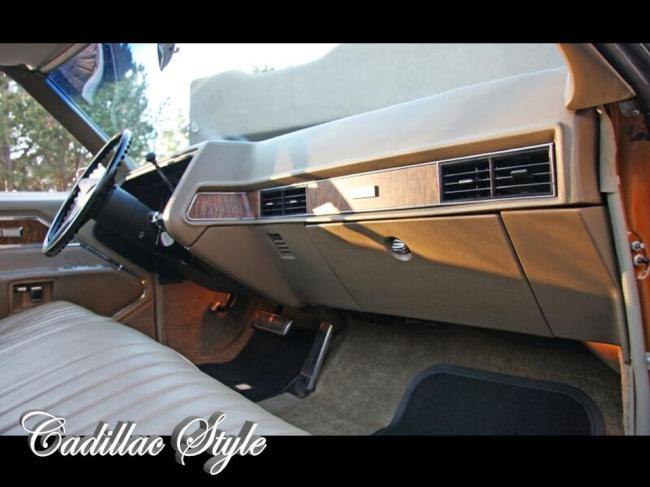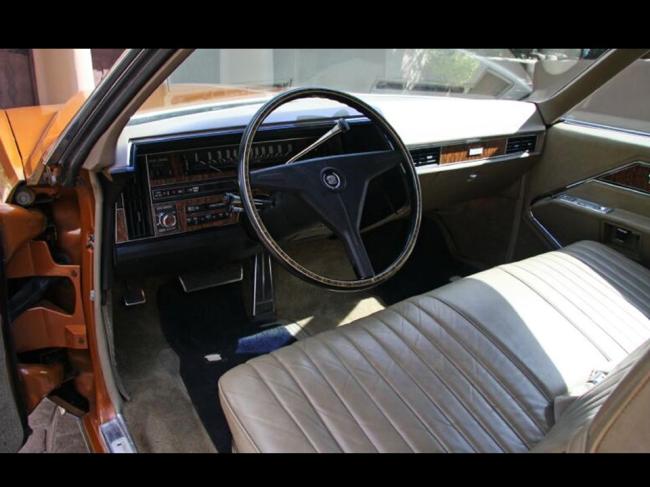1970 Cadillac Fleetwood Eldorado 8.2 litre
………The only way to travel was
The world’s finest personal luxury car without conjecture was the Cadillac Fleetwood Eldorado for 1970, Long, low-slung and unmistakably the “Standard of the World.” Cadillac’s exclusive 8.2 litre 500 cubic inch V8 was introduced for this masterful motorcar. The combination of front-wheel drive, Automatic Level Control, and variable ratio power steering made the 1970 Fleetwood Eldorado world-class. The poised dignity, hallmark of every Cadillac was expressed no more magnificently than this supreme achievement in motoring.
The exciting news for the “Standard of the World” was the all-new 8.2 litre 500 CID 16-valve OHV V8 engine. It was the largest engine to power a passenger production car in the world. You-GO Cadillac! This massively powerful V8 produced an astounding 400 hp @ 4,400 rpm packin’ the prolific punch with 746 Nm of peak torque @ 3,000 rpm. These were REAL fire-breathing Cadillacs, and remember too; this was PRE-avarice with OPEC so America was still ridin’ high.
The engine was equipped with a Rochester 4MV 4-bbl down-draft Quadrajet carburetor with equalized manifold, mechanical fuel pump, dry-type air filter, improved automatic choke, and a controlled combustion system to reduce exhaust hydrocarbons. This formidable V8 sprinted from 0-60 mph in 7.6 seconds, 0-100 mph in 20.5 seconds, and had a top speed of 126 mph. It did the ¼ mile @ 89 mph in 15.6 seconds. The engine was mated to GM’s Turbo Hydra-Matic THM 425 3-speed automatic transmission. What a way to travel Cadillac style in the spirited seventies.
The 1970 Fleetwood Eldorado coupe was built as body on frame crafted completely by Fleetwood. It used a special fully boxed perimeter frame designed for its front wheel drive protocol. The Eldorado rode on a long 120” wheelbase and had the luxury length of 221”. It was 79.8” wide. It used a special front suspension with torsion bar to work with the drive wheels. Its rear had single leaf springs with two horizontal and two vertical shock absorbers.
Standard was Cadillac’s dual power braking system with independent front and rear operation. It was fitted with composite, finned rear drums and front disc brakes. Also standard was Cadillac’s constantly adjusting Variable Ratio Power steering. The 1970 Fleetwood Eldorado got top marks with the luxury-sport class in the personal luxury niche that it created in 1967. It was often duplicated but not replicated. The early Eldogs were like bulls wearing a tuxedo…..it fought fiercely but managed to remain unscathed without a rip in that tuxedo either…it didn’t even soil the satin white shirt! The front-wheel drive Eldorado had the competition runnin’ scared….and I loved it!
Open the door to “Another World” inside the 1970 Fleetwood Eldorado. Flat floors provided more room to the already spacious ambience. The youthful sportiness of its interior with the comfort of deep-seated luxury alerted one to the fact that this was no ordinary car. It was purposefully built to be the finest personal luxury car in the world. There were eight color combinations available in leather. Or handsome Duplex cloth was available in six colors. Freedom of spirit and a taste for luxury was the elegant Fleetwood Eldorado for 1970. The “Gilded-One” had a base price of $6,903 (no not a typo) and Cadillac crafted 23,842 for the 1970 model year. Style code #69347 series H Fleetwood Eldorado, was the “Standard of the World” in personal luxury.
Other standard features for the 1970 Fleetwood Eldorado included power windows, power seat, Cornering lamps, special courtesy lighting, and a host of other standard comfort and convenience features to make every driving experience relaxing with effortless operation…..that was the Cadillac way of life. Among the popular options available for the 1970 Fleetwood Eldorado were: power sunroof, power door locks and trunk release, Dual Comfort front seats, Automatic Climate Control air conditioning, Cruise control, Twilight Sentinel, Guide-Matic headlamp control, Tilt & Telescopic steering wheel, radio foot-control, stereo tape player, and right side remote outside rearview mirror.
There was no more exciting way to motor in the spirited seventies than with the formidable 1970 Cadillac Fleetwood Eldorado coupe. With front-wheel drive, Automatic Level Control, and Variable Ratio Power steering all standard, the Eldorado was a most unique expression of Cadillac luxury and elegance. The newly designed 500 cubic inch V8 delivered 400 horses which was astonishing for a luxury car – The 1970 Cadillac Fleetwood Eldorado was another sparkling example in the continuing saga of “As the Standard of the World Turns.” Will there ever be another “Standard of the World?”
Special thanks to Matt Garrett/GM Classics for the photos
The “Standard of the World” in personal luxury






















can we have these comments in french?
can we have a technical sheet and do you have a french Partner?
I have a ’70. The sunroof is actually a pretty rare option. It was only introduced part way through the model year. It’s about the only option mine missed out on. It was good to see the photos of the roof. Thanks.
A sunroof is something we take for granted today! The 1970 Fleetwood Eldorado is definitely a keeper. Be kind to it as they are the last of an impressive breed. The Fleetwood Eldorado was the only car in the world to come standard with front-wheel drive, automatic level control, variable ratio power steering, power brakes, and automatic transmission. It is also one of the last model years to proudly bear the “Standard of the World” enigma. They are truly symbolic of what America had to offer in the luxury automobile market segment. Glad you enjoyed the article, please stop by any time!
Can anyone tell me more about the automatic level control and how it functions? Also does anyone have any technical drawing and /or pics of the frames of these cars?
Hello Stuart! Automatic Level Control was invented by General Motors. The earlier systems utilized all 4 wheels, but they refined the system to use the network for the rear wheels only since they do most of the work. The system works with a compressor under the hood and sensors at the rear with specially designed dampers (shock absorbers). Automatic Level Control keeps the vehicle at optimum height under any road condition and automatically adjusts for change in load. Automatic Level Control provides pressure from a compressor under the hood and air reservoir to a valve located at the rear crossmember of the frame.
If the rear end load deflected the suspension ½” or greater the valve would open allowing pressurized air to enter air chambers in the rear shock absorbers. When the load decreases the valve would exhaust the air from the shock absorbers to lower the car to the correct level height. The valves are calibrated with a 6-12 second delay so that normal deflection of the rear suspension while encountering uneven pavement would not activate the system. GM further refined this system to be “Electronic Level Control” for the contemporary vehicles. Instead of being a hydraulic system using air from a compressor, it is now electronically adjustable to save weight reducing the number of components needed. This is why General Motors is the luxury leader. Cadillac was the first to use this trype of system to maintain the car’s proper poise under any road or load condition. The rest of the industry followed suit.
Later into the mid 70’s, the system also allowed manual operation by providing an air valve under the hood, where you could inflate the system using a external air hose.
The problem is over a short time… these system always sprang leaks and failed. Of the 5 Caddy’s I owned. The 6 my father owned and everyone else I’ve known who owned one with self-leveling suspension, they all failed after 5 years of so, leaving the tail end of the car to sag with even slightest increase in rear load.
The cost to repair these issues is using more than most want to pay. Just about everybody opts for heavy duty (and adjustable air shocks) shock replacement to firm up the rear suspension permanently. However, this takes away for the soft floating ride Cadillac is renowned for.
Hey Sam! The real reason those primitive air suspensions failed was due to the fact I don’t think the designers realized how heavy those cars were. Then, an automobile of this magnitude in motion shifting weight around. The primitive systems weren’t digital with the capability of adjusting the suspension compensating for fuel consumption and the passengers moving about inside the cabin.
Materials used for the air bags weren’t suitable for everyday life outdoors. Those bags burst at thee most embarrassing moments. When I was a kid I saw an Eldorado Brougham backing off a steep incline and heard a loud ‘POP’ and the car was lop-sided! I asked my dad what happened and he was laughing so hard he could barely tell me “GM’s” horrid air suspensions were junk!
Not sure I’d call this car a “perimeter frame” design.
It has a front subframe that holds the UPP (Unitized Power(plant?) Package?—engine, transmission) and of course the steering and front suspension (torsion bars attached to the frame rails).
But the frame actually ends around the rear seat. The car is a unibody in the rear! You can see that from looking at how the trunk area is done, with the spare tire neatly tucked in. It is very much unibody.
The design is similar to the Firebird and Camaro of a few years later (1970-1980? those were made), they also have a front subframe (but with traditional A-arm suspension since they are RWD) and use shackled leaf springs to attach the rear suspension to the unibody in the rear, same as the 67-70 Eldorado.
I have a 1968 Eldorado and you can “feel” the difference in the front vs. the rear when you go over bumps. The rear suspension definitely transfers bumps more to the body.
The Eldorados went to full perimeter frame in 1971. Maybe to make them quieter.
Hello Mika! The 1970 Cadillacs ALL rode on a fully boxed perimeter frame. Yes, It does support the UPP and has a rear sub-frame; however, according to “The GM Heritage Center” 1970 Cadillac design book Page “F-18″ of this manual states that: ” The Eldorado frame is specifically designed to fit the structural requirements of its front-wheel drive.
The frame is of a fully boxed design encircling the passenger compartment and ending at the rear seat.
A sub-frame integral with the body is used at the rear to meet structural requirements. This sub-frame combined with front-wheel drive permits taking maximum advantage of space at the rear of the car for the trunk.”
There is NO unibody construction here. This is a big car and must ride on a full frame to keep it all together. The front and rear suspensions are integrated into this fully-boxed frame. Yes, it does differ from Fleetwood/DeVille/Calais models because they are rear-wheel drive.
Nowhere does the GM Heritage Center 1970 Cadillac manual tout unibody construction. But don’t take my word for it simply go to the GM Heritage Center and look up “Vehicle Information Kits” and select the 1970 Cadillac. I always research what I write to share with my readers, I never use my own conjecture posting facts.
These facts belong to the automobile manufacturers, I always use just what they say because after all, they made the car right? You are on it as far as the front and rear suspensions being separate, but there’s no unibody construction in 1970 Cadillac models.
Is there a problem with drive train with 70’s, please?